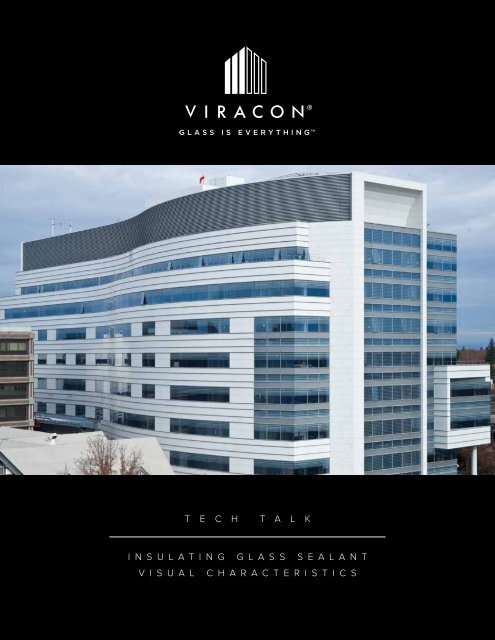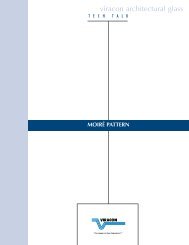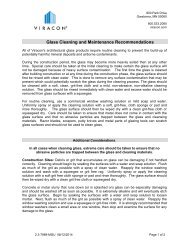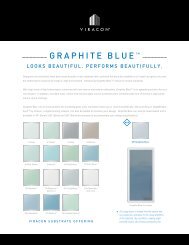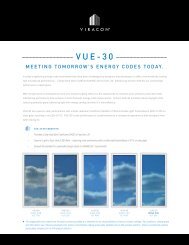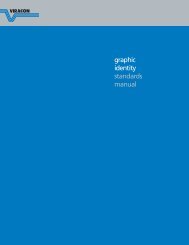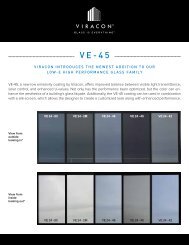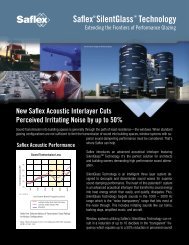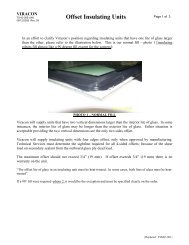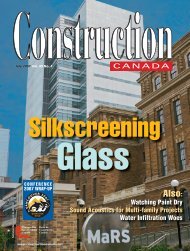TTIGVisualCharacteri.. - Viracon
TTIGVisualCharacteri.. - Viracon
TTIGVisualCharacteri.. - Viracon
- No tags were found...
Create successful ePaper yourself
Turn your PDF publications into a flip-book with our unique Google optimized e-Paper software.
®T E C H T A L KINSULATING GLASS SEALANTVISUAL CHARACTERISTICS
INSULATING GLASS SEALANT VISUAL CHARACTERISTICSThe use of insulating glass continues to grow worldwideas a result of the desire to build more energyefficient buildings. The various types of glazing systemsutilized today require insulating glass units tobe accommodating in their structural characteristic aswell as the visual aspects of the unit.Insulating Glass FabricationIn the process of fabricating the air spacer, roll formedaluminum or stainless steel are cut to size and thecorners are bent to 90°. The ends of the spacer areconnected together with a straight key. Polyisobutylene(PIB) is extruded onto both sides of the air spacersimultaneously. This is done with as much precisionas possible considering the extrusion rate of wetsealants inherently varies. The amount of PIB beingextruded may fluctuate some, as well as the actual locationof the PIB placement on the spacer bar. Sincethe sealants, both PIB and silicone are wet, the shapeof the PIB and general uniformity may also fluctuatewhen the glass and air spacer are pressed together.After assembly of the insulating glass units components(glass and spacer), the unit is pressed togetherby large platens. The pressure applied is regulated toachieve the desired overall thickness. The pressingcauses the round bead of extruded PIB to flatten outand widen between the glass plies.The PIB may extend into the vision area of the insulatingglass unit or not completely cover the spacer.<strong>Viracon</strong>’s internal specification for sightline tolerance,which includes placement of the air spacer in relationto the glass edge is +/- 1/8” as fabricated for the requiredsightline. This includes the sealant and spacer.The glass industry as a whole, has the same tolerancefor the sightline of an insulating glass unit. TheInsulating Glass Manufacturers Alliance (IGMA) VoluntaryGuidelines for Visual Obstructions in an InsulatingGlass of ~3mm (0.12”) sightline infringement isallowed and consistent with <strong>Viracon</strong>’s internal tolerances.In general we concentrate on the integrity ofthe seals from a warranty standpoint; as such we donot consider spacer showing or even the opposite,where PIB exudes over the spacer into the visionarea of the unit to be a defect.PIB / SpacerNot PressedPIB / SpacerPressedSightline Tolerance<strong>Viracon</strong> has performed testing on insulating glassunits that have PIB visible in the vision area and theseunits have performed comparably to units that maynot have PIB completely covering the aluminum spacer.Due to <strong>Viracon</strong>’s specification and design of thePIB seal, we have sufficient coverage and integrity of
this seal in relation to the air spacer coverage. In bothcases, the integrity of the insulating glass seal will notbe compromised. The performance of the glass and<strong>Viracon</strong>’s warranty for the glass is unaffected.PIB Inherent CharacteristicsIt should also be recognized that the PIB is a noncuringsealant. Therefore over the life span of the insulatingglass unit, the PIB will flow under elevatedtemperatures and some degree of movement intothe vision area of the glass will undoubtedly occurover time. The degree to which this will occur will bea function of time, temperature, orientation and typeof glazing system.result, these inconsistencies are deemed acceptableproviding the insulating glass unit integrity is not compromised.From a design or aesthetic standpoint, when installedin a captured system, the edge of the insulating glassunit will not be seen when properly designed. In astructurally glazed system, the edge of the insulatingglass unit will be visible from the exterior of thebuilding and potentially for the interior of the buildingif the insulating glass unit’s sightline is greater thanthe amount of interior framework coverage. In thesesituations, consideration must be given to increasingthe amount of glass edge coverage to mitigate sealantand spacer visibility, from inside the building. Onemay also consider utilizing a black air spacer insteadof the silver mill finish aluminum or stainless steelspacer.In the interest of mitigating to some degree the potentialfor extreme PIB movement, <strong>Viracon</strong> has takeninto consideration the variables that we can controlsuch as volume, placement and pressure. As a resultwe strive to lessen the potential and amount of PIBthat may ultimately migrate into the vision area, understandingthat this cannot be totally avoided. As aresult, a portion of the air spacer may not be coveredby the PIB and our tolerance would allow for 3/32”of uncovered spacer. From a practical standpoint, thePIB will never be perfectly straight given fluctuationsin the extrusion process such as pressure, temperatureand extrusion speed.AestheticsIn years past, the appearance of the edge of the insulatingglass was not taken into consideration whenstructurally glazed because of the very dark or highlyreflective glass that was often used in curtain wall applications.Today, the most popular types of glass areclear with high light transmitting coatings that do nothide any of the inconsistencies that are common ininsulating glass fabrication processes. Unfortunatelythere are no standards for the appearance of an insulatingglass unit edge in our industry today. As aGlazing SystemsIn the past, insulating glass units were installed suchthat all edges of the glass were firmly held in placewith the metal stops, pressure plates or snap oncovers. All of these systems generally utilize rubbergaskets or a combination of gaskets and sealants toprotect the glass from glass to metal contact as wellas to provide a resilient material to form a water tightbarrier to the building exterior. Dry glazing systemsor compression gasket systems rely upon clampingpressure to provide a barrier against air and waterinfiltration.The Glass Association of North America’s (GANA)glazing manual, provides general glass and glazinginformation. In this manual, the edge clamping pressureapplied to glass in a pressure glazed system islimited to a range of 4-10 pounds per lineal inch. Thisrange would prevent excess pressure from being appliedto the glass edge. A dry glazed system utilizes
®The information contained in this publication is presented in goodfaith. It is believed to be accurate at the time of publication. <strong>Viracon</strong>reserves the right to change product specifications without noticeand without incurring obligation.viracon.com800 Park Drive, Owatonna, MN 55060800.533.2080Copyright © 2011 <strong>Viracon</strong>.All Rights Reserved.VR0311


